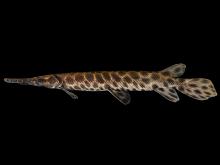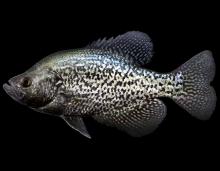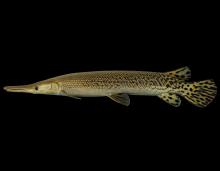Fishes
Media

Species Types
Scientific Name
Ctenopharyngodon idella
Description
Grass carp are large-bodied with a broad head and a terminal transverse mouth. The scales appear crosshatched. A native of east Asia, it is now widely distributed in the Missouri, Mississippi, and St. Francis rivers and in impoundments.
Media

Species Types
Scientific Name
Cyprinus carpio
Description
The common carp is a "whopper" member of the minnow family. Originally from Asia, it was actively stocked in America in the 1800s and was firmly established in Missouri by 1895.
Media

Species Types
Scientific Name
Lepisosteus oculatus
Description
The spotted gar has many well-defined roundish black spots on top of the head and on the paired fins. Like other gars, it's a long, cylindrical fish with a long snout and numerous prominent teeth. The body is covered with hard, diamond-shaped scales.
Media

Species Types
Scientific Name
Amia ocellicauda (formerly Amia calva)
Description
The eyetail bowfin is a stout-bodied, nearly cylindrical fish. It is most abundant in the Mississippi Lowlands, though it occurs along the entire length of the Mississippi River.
Media

Species Types
Scientific Name
Pomoxis annularis
Description
The white crappie, a popular panfish, has silver sides with 5 to 10 often faint vertical bars. The upper jaw reaches past the middle of the eye. It is more abundant and widespread than the black crappie.
Media

Species Types
Scientific Name
Pomoxis nigromaculatus
Description
The black crappie is a popular panfish. It is deep bodied and slab sided. The sides are silver with an irregular pattern of dark speckles. The upper jaw is long, reaching past the middle of the eye.
Media

Species Types
Scientific Name
Lepisosteus osseus
Description
The longnose gar has a longer, narrower snout than our other three gars and is the most widely distributed gar in Missouri.
Media

Species Types
Scientific Name
Sander vitreus
Description
MDC has been stocking walleye, a popular game fish, in lakes and reservoirs including Stockton, Lake of the Ozarks, Bull Shoals, and numerous other reservoirs.
Media

Species Types
Scientific Name
Atractosteus spatula (formerly Lepisosteus spatula)
Description
The alligator gar is Missouri's largest gar and has a distinctively short, broad snout. Populations are declining. This fish once occurred in the Mississippi River at least as far upstream as the mouth of the Illinois River and in major tributaries.
Media

Species Types
Scientific Name
Moxostoma macrolepidotum
Description
The shorthead redhorse is the most widely distributed redhorse sucker in Missouri, occurring nearly statewide. No other Missouri redhorse is as adaptable in its habitat requirements. Many specimens have a pea-shaped swelling on the upper lip.
See Also


Media

Species Types
Scientific Name
Amphiuma tridactylum
Description
The three-toed amphiuma is an eel-like, completely aquatic salamander. It has very small forelimbs and hind limbs, each with three tiny toes. In Missouri it’s found only in the Bootheel region.
Media

Species Types
Scientific Name
Siren intermedia nettingi
Description
The western lesser siren is an eel-like, aquatic salamander with external gills, small eyes, small forelimbs with four toes, and no hind limbs. In Missouri, it’s found mostly in the Bootheel and northward in counties near the Mississippi River.
About Fishes in Missouri
Missouri has more than 200 kinds of fish, more than are found in most neighboring states. Fishes live in water, breathe with gills, and have fins instead of legs. Most are covered with scales. Most fish in Missouri “look” like fish and could never be confused with anything else. True, lampreys and eels have snakelike bodies — but they also have fins and smooth, slimy skin, which snakes do not.





















